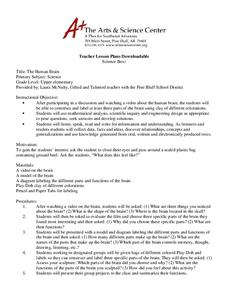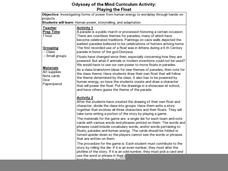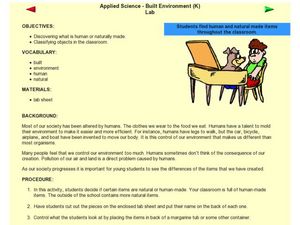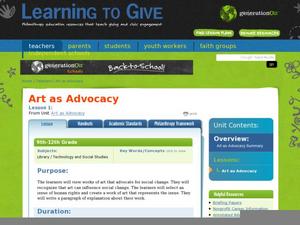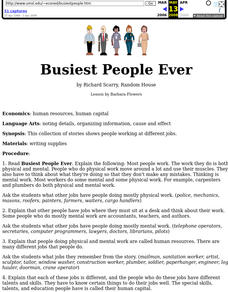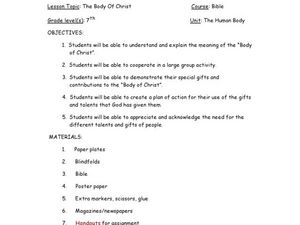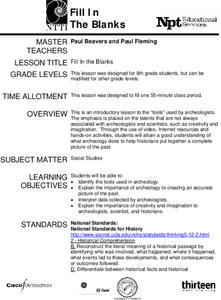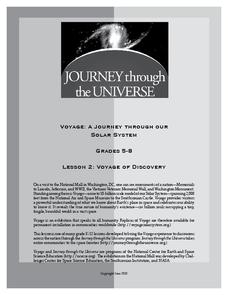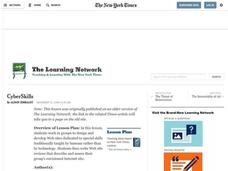Advocates for Human Rights
Human Rights Defined
Class members continue their investigation of the factors that influence migration with a lesson on human rights. As they examine the Universal Declaration of Human Rights and selected US Constitutional Amendments, learners compare the...
Curated OER
The Human Brain
Students identify parts of the human brain. In this biology instructional activity, students watch a video about the human brain. Students use different colors of clay to construct and label the three parts of the brain.
Odyssey of the Mind
Odyssey of the Mind Curriculum Activity: Playing the Float
Got a rainy day and need a few fabulous activities to foster creative thinking skills? The class works to understand the three types of human power; direct, indirect, and stored. They do this by first creating a parade float like the...
Amnesty International
Respect My Rights, Respect My Dignity Module Three – Sexual and Reproductive Rights Are Human Rights
Give learners the support they need to take action in their communities when it comes to sexual and reproductive rights. A resource teaches the class about global issues surrounding gender inequality, including both readings and...
Odyssey of the Mind
Odyssey of the Mind Curriculum Activity: Making of a Monster
Over the course of a week, the class will study how monsters are portrayed throughout literature. But why? Monsters in science fiction or horror often depict the darker side of human nature; they are described for their horrific physical...
Odyssey of the Mind
Odyssey of the Mind Curriculum Activity: GREAT TO COMMUNICATE
Humans love to communicate and they do it in so many different ways. The class investigates how people have used new inventions and technological innovations to communicate. They are divided into groups of three or four and given...
Odyssey of the Mind
Odyssey of the Mind Curriculum Activity: My Robot and Me
Robots and their interactions with their human counterparts are the catalyst for a fun writing instructional activity. First, the class brainstorms what they'd like to have their personal robot do or be capable of. Then, they each write...
Curated OER
Human or Natural?
Students explore nature by participating in a class lab activity. In this human vs. nature lesson, students examine a group of items in their classroom and discuss whether they were created naturally or have been altered or created by...
Curated OER
Images as Messages
Your class watches a video about Chris Jordan, a talented photographer and activist who tries to get an environmental message out by his work. As a cross-curricular project, have your class imitate his style of art with an object that...
Curated OER
Philanthropy and You
Students identify human rights and study the values of historical figures who fought for human rights. In this human rights lesson, students define the term human rights and research examples of human mistreatment in history. Students...
Curated OER
Wall of Philanthropists: King Day (7th)
Young scholars recognize the importance of justice, tolerance, equality, and historical figures. In this philanthropic actions lesson, students study the philanthropic actions of historical figures, and learn about the concepts of...
Curated OER
Art as Advocacy for Social Change
“Humanscape No.65” by Melesia Casas and Ester Hernandez’s “Sun Maid Raisins” launch a study of how works of art can advocate for social change. After examining these two works and discussing the human rights issues raised, class members...
Maryland Department of Education
The Concept of Diversity in World Literature Lesson 4: Proverbs
"Eneke the bird says since men have learnt to shoot without missing, he has learnt to fly without perching." As part of their study of Things Fall Apart, class members read Paul Hernadi and Francis Steen's essay, "The Tropical Landscapes...
Curated OER
Figurative Language in Romeo and Juliet
Shakespeare was such a talented writer, but why? It must be his use of figurative language, blended with his clever, twisting plots. This worksheet focuses on his use of metaphor, simile, personification, oxymoron, and hyperbole within...
Concordia University Chicago
The Pietá by Michelangelo Buonarroti
Why is arts education so important? It builds critical thinking, analysis and creative problem-solving skills. Learners review the life of Michelangelo Buonarroti, and then analyze his piece, The Pieta. After that, they'll sculpt a human...
Curated OER
Busiest People Ever
Students write a paragraph about what they want to do when they grow up. They include the special skills and education (human capital) they must have to do the job they've chosen.
Curated OER
The Body of Christ
Seventh graders consider their own unique talents. In this church body lesson, 7th graders identify their personal contributions to the Body of Christ. Students create a collage and work with partners in a trust building exercise.
Curated OER
Music of the Civil Rights Era, 1954-1968
Students experience the aesthetics of music and learn about freedom songs that motivated the Civil Rights activists. In this music history lesson, students learn how music can motivate and move listeners. Students then describe how...
Curated OER
Fill in the Blanks
Archaeologists, historians, and scientists all work together to create a timeline of our past. Engages learners in a series of activities that all filter through the NOVA video, "Mysteries of the First Americans." Each activity is...
Odyssey of the Mind
Odyssey of the Mind Curriculum Activity: Balance the Books
There is a difference between profit and revenue, and it's up to your class to find out why. They each research the public accounting documents for their favorite company or brand. Then they use their findings to discuss the differences...
Curated OER
Fame, Fortune, and Philanthropy
With your middle schoolers, develop concepts such as philanthropy, civic responsibility, community service, and common good. Discuss famous philanthropists and what we can each give of our time, talent and treasure to better our...
Journey Through the Universe
Voyage of Discovery
Did you know that Pluto is smaller than the United States of America? It is difficult to conceptualize the size of planets and the distance between them, and the activity addresses those exact issues. After a discussion, pupils create...
Curated OER
Cyber Skills
Students, in groups, design and develop Web sites dedicated to special skills traditionally taught by humans rather than by technology. They write Web site reviews that describe and assess their group's envisioned Internet site.
Curated OER
Our Many Shapes and Sizes
Learners discover humans come in all shapes and sizes. In this equality instructional activity, students evaluate different bodies among their peers and discover no human body is "perfect". Learners discuss different ways to...



